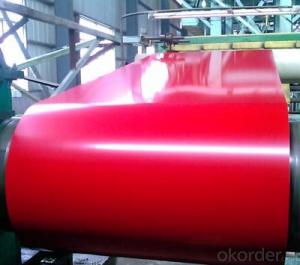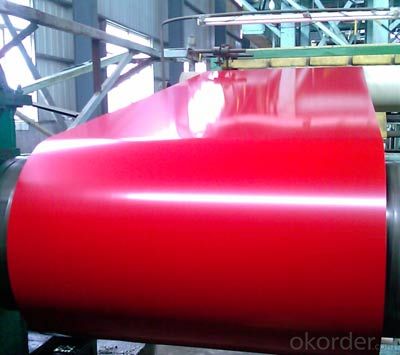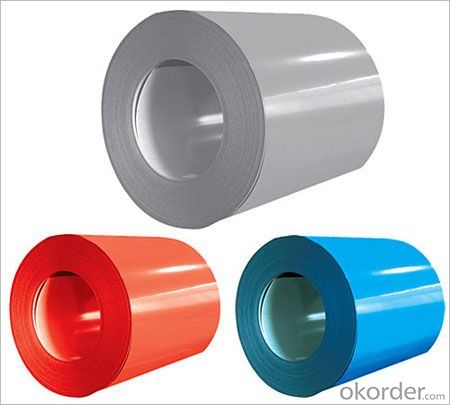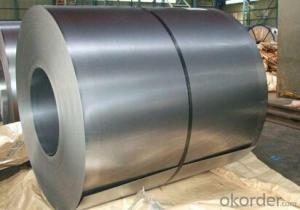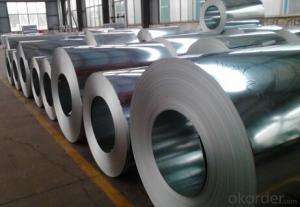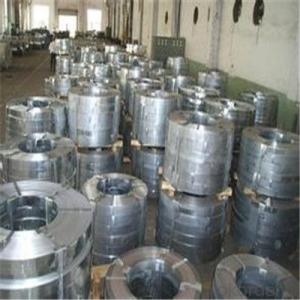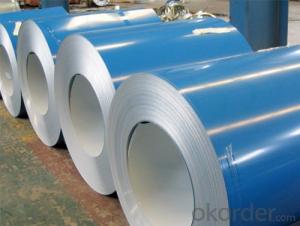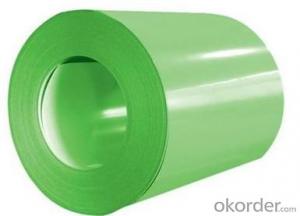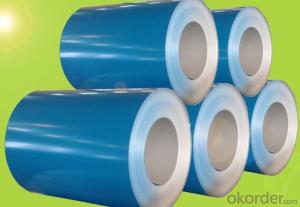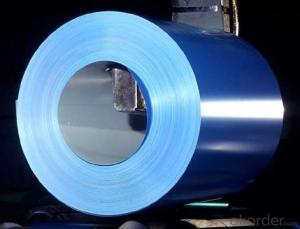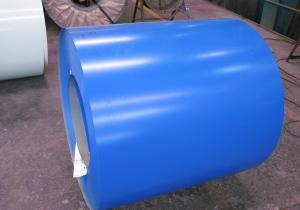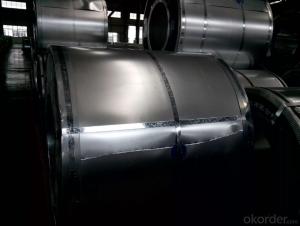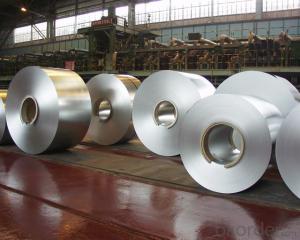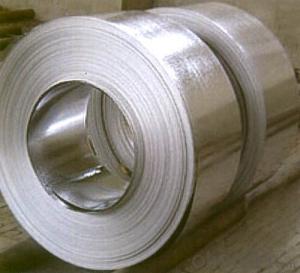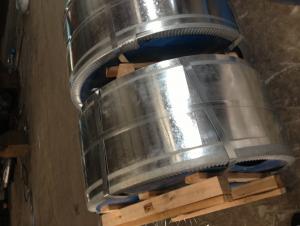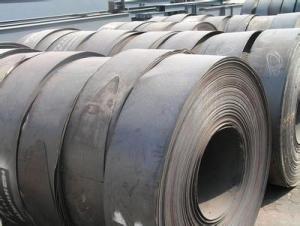Pre-painted Galvanized/Aluzinc Steel Sheet Coil with Prime Quality and Lowest Price color is red
- Loading Port:
- Shanghai
- Payment Terms:
- TT OR LC
- Min Order Qty:
- 100 m.t.
- Supply Capability:
- 10000 m.t./month
OKorder Service Pledge
OKorder Financial Service
You Might Also Like
1.Structure of Pre-painted Galvanized/Aluzinc Steel Coil Description
With GI (aluzinc) as base metal, after pretreatment (degrease and chemical treatment) and liquid dope with several layers of color, then after firing and cooling, finally the plate steel is called pre-painted galvanized (aluzinc) steel. Pre-painted galvanized steel is good capable of decoration, molding, corrosion resistance. It generally displays workability, durability and weather resistance.
2.Main Features of the Pre-painted Galvanized/Aluzinc Steel Coil
• Excellent corrosion resistance
• Excellent weather resistance
• Capability of decoration, molding, corrosion resistance
• Workability, durability
• Excellent heat resistance performance
• High strength
• Good formability
• Good visual effect
3.Pre-painted Galvanized/Aluzinc Steel Coil Images
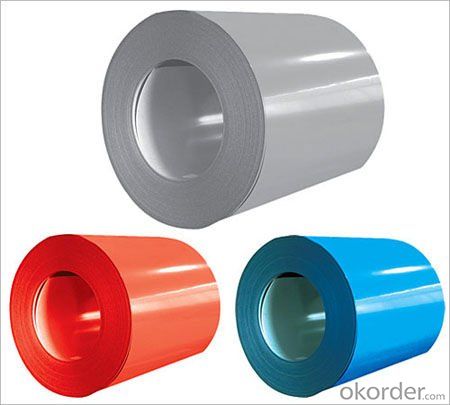
4.Pre-painted Galvanized/Aluzinc Steel Coil Specification
Quality standar: JIS G3312 CGCC & CGLCC
Hardness of P: Both soft and hard quality are available
Surface finish: with or without protect film
Thickness : 0.14-1.20 mm
Width : 914mm, 1000mm, 1220mm and 1250mm, thickness 600-1250mm is available
Finish by coil or sheet: Both sheet and coil are available
8Zinc coating: 60-275G/M2, both sides
Paint thickness for top side : 5 micron primer + (10-20) microns modified polyester, blue color code.
Paint thickness for back side: (5-10) microns Epoxy
Weight per coil: 4-6 tons, also can be upon customer's requirements
Max loading weight in one 20ft container : 25 tons generally
5. FAQ of Pre-painted Galvanized/Aluzinc Steel Coil
We have organized several common questions for our clients,may help you sincerely:
1. What is the minimum order quantity ?
Our MOQ is 50mt for each size. And we will consider to give more discount if you make big order like 1000 tons and more. Further more, the more appropriate payment term your offer the better price we can provide.
2. How long can we receive the product after purchase?
Usually within thirty working days after receiving buyer’s advance payment or LC. We will arrange the factory manufacturing as soon as possible. The cargo readiness usually takes 15-25 days, but the shipment will depend on the vessel situation.
3. How to guarantee the quality of the products?
We have established the international advanced quality management system,every link from raw material to final product we have strict quality test;We resolutely put an end to unqualified products flowing into the market. At the same time, we will provide necessary follow-up service assurance.
- Q: Can steel strips be used for making precision stampings?
- Yes, steel strips can be used for making precision stampings. Steel strips are often used in stamping processes due to their strength, durability, and ability to maintain tight tolerances. Precision stampings require accurate and consistent shaping of the metal, and steel strips provide the necessary stability and uniformity for such applications. Additionally, steel strips can be customized to different thicknesses, widths, and alloys to meet specific requirements, making them versatile for various precision stamping projects.
- Q: What are the common thickness ranges for steel strips?
- The specific application and industry requirements determine the common thickness ranges for steel strips, which can vary. Generally, steel strips can have thicknesses ranging from 0.001 inches (0.0254 mm) to 0.25 inches (6.35 mm). These thickness ranges are commonly utilized in the automotive, construction, manufacturing, and aerospace industries. The required thickness would depend on factors like intended use, strength requirements, and manufacturing process. Diverse thicknesses of steel strips provide varying levels of flexibility, strength, and durability, enabling their wide application across multiple industries.
- Q: Are steel strips suitable for making musical instruments?
- Musical instruments can indeed be made using steel strips. Steel, being a versatile material, offers numerous advantages in the craft of instrument making. One prevalent application of steel strips in musical instruments involves the creation of strings. In instruments like guitars, pianos, and violins, steel strings are widely utilized due to their ability to produce a bright and clear sound. Additionally, steel strips can be employed in constructing the body or resonating parts of certain instruments such as steel drums or steel guitars. The durability and strength of steel make it an exceptional choice for instruments that endure frequent use and tension. Moreover, steel strips can be molded and manipulated to produce various tones and sounds, rendering them an adaptable option for instrument makers. Nonetheless, it is important to acknowledge that the selection of materials for musical instruments relies on the specific requirements and desired characteristics of the instrument. Factors like weight, resonance, and tonal qualities may also influence the suitability of steel strips for a particular instrument.
- Q: Can steel strips be used in automotive applications?
- Yes, steel strips can be used in automotive applications. Steel strips are commonly used in the automotive industry for various purposes such as manufacturing body panels, chassis components, and structural reinforcements due to their high strength, durability, and ability to withstand extreme conditions.
- Q: How are steel strips used in the manufacturing of bridges?
- Steel strips are commonly used in the manufacturing of bridges as they provide strength, durability, and flexibility. These strips are often used as reinforcement in the concrete structures of the bridge, such as in the beams and columns, to enhance their load-bearing capacity. Additionally, steel strips can be formed into various shapes and sizes to meet specific design requirements, ensuring the bridge's structural integrity.
- Q: How are steel strips used in the production of metal brackets?
- Due to their versatility and durability, steel strips find common use in the production of metal brackets. These strips are typically crafted from high-quality steel, which imparts the necessary strength and stability that brackets require. During the manufacturing process, steel strips are initially cut to the desired length and width, based on the specifications of the bracket being produced. This allows for greater adaptability in creating brackets of varied sizes and shapes. Once cut, the steel strips undergo a series of forming operations, such as bending, stamping, or rolling, to shape them into the desired bracket design. The choice of machinery and techniques for these forming operations depends on the complexity of the bracket. Steel strips also play a vital role in ensuring the structural integrity of the brackets. They provide a robust foundation and support, enabling the brackets to withstand heavy loads and maintain their shape under pressure. This is particularly crucial in applications where the brackets are utilized to support heavy objects or machinery. Furthermore, steel strips are often coated or treated to enhance their resistance to corrosion. This is of utmost importance in applications where brackets may be exposed to harsh environments or corrosive substances, as it aids in prolonging their lifespan and preserving their functionality. In conclusion, steel strips are an indispensable component in the production of metal brackets, offering the strength, flexibility, and durability necessary for a wide range of applications.
- Q: What are the common applications of hot-rolled steel strips?
- Hot-rolled steel strips are commonly used in various industries such as construction, automotive, and manufacturing. They are primarily used for making structural components, including beams, columns, and supports in buildings and bridges. Additionally, hot-rolled steel strips are utilized in the production of pipes, tubes, and railway tracks due to their high strength and durability. In the automotive sector, they are employed for manufacturing frames, chassis, and other structural parts. The versatility and cost-effectiveness of hot-rolled steel strips make them a popular choice in many applications where strength and reliability are crucial.
- Q: What are the sectors in which galvanized steel strips can be used?
- Same as steel plate, strip steel is divided into two kinds of ordinary strip steel and high quality strip steel according to the material used, and two kinds of hot-rolled strip steel and cold rolled strip steel according to processing method. Strip steel is widely used in the production of welded steel pipe, made of cold formed steel billet, manufacturing bicycle frame, rim, clamp, gasket, spring, saw blades, hardware and blades. The use of hot galvanized strip is naturally associated with the application of galvanized strip in construction, light industry, automobile, agriculture, animal husbandry, fishery and business. Now, with the improvement of various industries, electronics and other manufacturing processes, the application of materials is also more and more widespread.
- Q: What are the alternatives to steel strips in specific applications?
- Depending on the requirements and constraints, there are several options available as alternatives to steel strips: 1. Aluminum strips provide a lightweight and corrosion-resistant option. They are commonly used in industries like aerospace, automotive, and construction, where reducing weight and ensuring durability are crucial. 2. Copper strips are widely known for their excellent electrical conductivity and thermal properties. They find extensive use in electrical and electronic applications, such as transformers, motors, and electrical wiring. 3. Composite strips, such as carbon fiber reinforced polymers (CFRP) or fiberglass, offer high strength, stiffness, and corrosion resistance. These materials are commonly utilized in the aerospace and marine industries due to their favorable weight-to-strength ratio. 4. Plastic or polymer strips, like polyethylene or polypropylene, are suitable alternatives when chemical resistance, flexibility, or low friction properties are important. Industries like packaging, automotive, and healthcare frequently employ these materials. 5. Wood strips have long been utilized as a traditional alternative to steel, particularly in construction and furniture industries. Wood offers natural beauty, ease of working, and sustainability compared to steel. Before selecting an alternative to steel strips, it is essential to consider the specific requirements of the application, such as mechanical properties, weight, corrosion resistance, and cost. Each alternative material has its own advantages and limitations, and the choice will depend on the specific needs of the application.
- Q: How are steel strips rolled?
- Steel strips are rolled through a series of hot and cold rolling processes to achieve the desired thickness, shape, and surface finish. The process typically begins with a hot rolling mill, where a large slab of steel is heated above its recrystallization temperature and passed through a series of rollers to gradually reduce its thickness. The steel strip is then coiled and cooled. Next, the coiled strip is further processed through a cold rolling mill. This mill consists of multiple stands of rollers that gradually reduce the thickness of the steel strip to the desired level. Cold rolling not only reduces the thickness but also improves the surface finish, mechanical properties, and dimensional accuracy of the steel strip. During the cold rolling process, the steel strip is continuously annealed to remove any residual stresses and increase its ductility. Annealing involves heating the strip to a specific temperature and then slowly cooling it down. This process helps to refine the microstructure of the steel and improve its overall quality. After cold rolling and annealing, the steel strip may undergo additional processes such as skin pass rolling or temper rolling. Skin pass rolling involves a light reduction in thickness to improve the surface finish and remove any defects. Temper rolling, on the other hand, involves passing the steel strip through a series of rolls to impart specific mechanical properties and eliminate any residual stresses. Finally, the steel strip is typically coated or treated to prevent corrosion or enhance its surface properties. This can involve processes such as galvanizing, where a layer of zinc is applied to protect the steel from rusting. In summary, steel strips are rolled through a combination of hot and cold rolling processes, which gradually reduce the thickness and improve the surface finish and mechanical properties of the steel. These strips are then further processed and treated to achieve specific characteristics and prevent corrosion.
Send your message to us
Pre-painted Galvanized/Aluzinc Steel Sheet Coil with Prime Quality and Lowest Price color is red
- Loading Port:
- Shanghai
- Payment Terms:
- TT OR LC
- Min Order Qty:
- 100 m.t.
- Supply Capability:
- 10000 m.t./month
OKorder Service Pledge
OKorder Financial Service
Similar products
Hot products
Hot Searches
Related keywords
